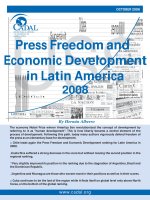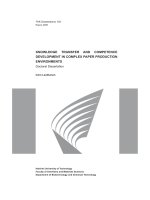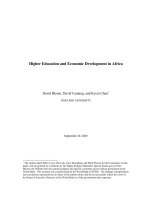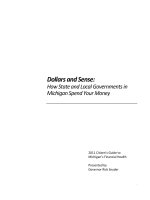Indigenous knowledge of traditional medicine and local development in Myanmar: The case of Calotropis Gigantea R. BR. in Ayeyarwady region
Bạn đang xem bản rút gọn của tài liệu. Xem và tải ngay bản đầy đủ của tài liệu tại đây (468.13 KB, 7 trang )
INDIGENOUS KNOWLEDGE OF TRADITIONAL MEDICINE AND
LOCAL DEVELOPMENT IN MYANMAR: THE CASE OF
CALOTROPIS GIGANTEA R. BR. IN AYEYARWADY REGION
Thandar Aung
Department of Chemistry, Pathein Universit
Theint Theint Phyo
Department of Chemistry, Pathein University
Abstract
Medicinal plants are abundant in Myanmar. Most of people use the traditional
medicinal plants for the treatment of diseases. The study of Traditional Medicinal plants
and their therapeutics play a very important role in health care system of Myanmar
because 70 % of its population is in the rural area and they have been using traditional
medicine for centuries. Myanmar traditional practitioners use a variety of medicine mostly
containing potent medicinal plants available in Myanmar, to cure various diseases
depending on their own nature and localities. Calotropis gigantea R. Br., a widely growing
plant, possesses number of medicinal properties. This research focused on the use of
Myanmar Indigenous Medicine of the leaves of Calotropis gigantea R.Br. in Ayeyarwady
Region, socio economic and environmental impact, and the investigation of some
phytoconstituents and bioactivities.
Key words: Calotropis gigantea R.Br., phytoconstituents, traditional medicinal plants
1. Introduction
Calotropis gigantea R.Br. (Mayo), a member of the Apocynaceae family, is a wellknown plant throughout the tropical world and they are native to the tropical and
subtropical parts of Asia and Africa (Sharma, 1934). In Myanmar, the plant is distributed
in various regions and used as remedy for various medicinal purposes. Myint Myint Khine
reported for her PhD dissertation that leaves of Calotropis procera R.Br. (Ma-yo)
possessed antimicrobial activity (Myint Myint Khine, 2007). The importance of medicinal
plants to the economy of low-income countries remains critical and strategic because
medicines are keys to a health population that drives and sustain the economy. In this
research work, the leaves of Calotropis gigantea R.Br. (Mayo) was chosen for
investigation of some phytochemical constituents, and their bioactivities, its uses, and
analyzing the socio-economic aspects of sample in Ayeyarwady Region.
328
Figure 1 Image of Calotropis gigantea R.Br.
Botanical Aspect of Calotropis gigantea R.Br.
Family
: Apocynaceae
Sub-family
: Asclepiadaceae
Botanical name
: Calotropis gigantea R.Br.
Myanmar name
: Mayo
English name
: Swallow-Wort, Milk weed
Synonyms
: Asclepias gigantea L.
Part used
: Leaves
Some Bioactive Chemical Constituents of C. gigantea R.Br.
Latex: cardiacglycosides, calotopin, uscharin, calotoxin, calactin and uscharidin; gigantin
Leaves: amyrin, amyrin acetate, ß-sitosterol, ursolic acid, cardenolides, calotropin,
calotropagenin
Flowers: flavonoids, queretin-3-ratinoside, sterol, calactin, calotoxin, calotropagenin,
calotropin, polysaccharides with D-arabinose, glucose, glucosamine and L-rhamnose.
Root bark: triterpenes, new norditerpenyl ester, calotropterpenyl ester
Medicinal uses of various parts of Calotropis gigantea R.Br. (Mayo)
The C. gigantea R.Br. (Mayo) plant is used for skin diseases, boils and sores and as
a tonic and purgative in small doses, and as an emetic in larger doses. The powdered root
bark is used to cure dysentery, elephantiasis, and leprosy. The stem bark is diaphoretic and
expectorant, and is used for dysentery, spleen complaints, convulsions, lumbago, scabies,
ringworm, and tumors and also as an antiseptic, vermifuge, emetic and purgative, as well
as for poisoning arrows. The powdered flowers are given for coughs, colds and asthma.
The crushed and warmed leaves are applied on burns, headaches and rheumatic pains, and
as a tincture for intermittent fever (Gaur et al., 2013).
329
2. AIM
The chemical properties and value of plants and their extracts, the development of
commercial that may arise from the chemical analysis; indigenous knowledge systems
linked to plants and their uses and ecological considerations. This paper is focus on local
application of medicinal plants and to improve healthcare system in Ayeyarwady Region.
3. Objectives
- To study the uses of various parts of Calotropis gigantea R.Br. (Mayo) in Myanmar
- To give some information that the leaves extracts of C.gigantea have antitumor,
antioxidant and larvicidal activities and no acute toxic effect
4. Genral information
General Uses of Calotropis gigantea R.Br. (Mayo)
There are two types of Calotropis gigantea ( white and red). Both are used to cure
vomiting, purgation, vata roga, leprosy, itching, snake bites, wounds, splenomegaly,
abdominal tumors, pileees, cough, ascites and intestinal worm infestation.
White type is aphrodisiac, light in nature and stimulates digestive system. It is used
to cure anorexia, excessive salvation, piles, cough and asthma. On the other hand, red type
is little bit bitter in taste. It is useful in diarrhea, abdominal tumors and inflammation. Is is
also useful in skin disorders, worm infestation, cough, hemorrhoids, and bleeding
disorders. The astringent action of the herb makes it beneficial for the treatment of many
skin diseases.
Leaves
Composing of Calotropis gigantea leaves using mix dung of buffalo, cow, goat and
sheep (Shah M. C, 2015)
Calotropis leaves are immersed in water for two days, diluted, filtered and is then
applied at the place of termite attack.
Flowers
Calotropis gigantea flower is efficacious as well as safe in patients with painful
heel syndrome (Peavin Dhone, TJ Hemanani, 2012)
Latex
Milky white latex is sticky and the plant is popular amongst the common population
because of this peculiarity. This is mildly poisonous and is considered as one of the plant
toxins in Ayurveda. Though toxic, this latex can be purified and put to use as a very
effective antidote as well as herbal medicine.
Latex is salted and bitter taste, having hot potency, light and oily in nature. It is best
used to cure skin disorders, abdominal tumors.
Latex of this plant is capable of vomiting and purgation. It is used in purgation and
vomiting therapy.
330
Root bark
The powdered root bark is used to cure dysentery, elephantiasis, and leprosy.
Stem bark
The stem bark is diaphoretic and expectorant, and is used for dysentery, spleen
complaints, convulsions, lumbago, scabies, ringworm, pneumatisms and tumours and also
as an antiseptic, vermifuge, emetic and purgative, as well as for poisoning arrows.
Local Uses of Calotropis gigantea R.Br. (Mayo)
In traditional practice, especially in Ayeyarwady Region, Myanmar, C.gigantea
(Mayo) is being used mainly
- By swallowing the mixture of leave with latex for the controlling of snake poison.
(Dosage -after grinding with leaves and latex, 0.5-1 g one pill per hour during snake bite)
- After boiling the whole parts of the plant sample, the obtained watery extract was
used to relief arthritic.
- By binding the heated leaves with clothes, that cures the furuncle, tumor, back
pain and knee pain.
- By mixing a piece of salt, 5 mL of honey, and powdered of Mayo leaf (1 g), it was
eaten by twice a day, that relieves asthma.
- By sticking with latex to the painful heel is efficacious in patients with painful heel.
- By mixing with latex to the milk, that solidifies the milk.
- By coating the mixture of turmeric powder with latex to the abdomen gradually
diminish the abdominal tumors.
Other Uses of Calotropis gigantea R.Br. (Mayo)
Calotropis gigantean plant yields a durable fiber that is used in rural households to
make bowstring, ropes, carpets, and sewing threads. Doing these activities can give some
incomes in the local region. Technical supporting is required to get high quality products.
Health care costs are a big issue in Myanmar, largely determining when and where
people seek treatment. Using the Calotropis gigantea plant systematically may improve
not only the prevention of healthcare system, on the other hand but also save money for
expense of medical cover. This may conserve local people to get happy and healthy their
working environment. Today, traditional medical practice has been recognized by the
world health organization (WHO) as a building block of primary healthcare. But, safety
should be the overriding criterion in the selection of herbal remedies for use in healthcare
(Patli et. al., 2012).
Myanmar traditional practitioners use a variety of medicine mostly containing
potent medicinal plants available in Myanmar, to cure various diseases depending on their
own nature and localities. These medicines may consist of a single potent plant as well as
in combination with other potent plants in different ratios by weight or by volume. From
331
studying the scientific point of view, results of preliminary photochemical analysis of the
leaves extract of C. gigantea showed that the leaves contain alkaloids, steroids, saponins,
glycosides, tannins and -amino acids.
For safety, acute toxicity screening of C.gigantea leaves, ethanol extract was done
with the dosage of 2000 mg/kg and 5000 mg/kg body weight in each group of albino mice
(WHO, 1963, 1966). The condition of mice groups were recorded after fourteen days
administration. The results show no lethality of the mice was observed up to fourteen days
administration. Each group of animals were also observed still alive and did not show any
visible symptoms of toxicity like restlessness, respiratory disorders, convulsion, aggressive
activities, coma and death.
Table 1. Acute Toxicity Effect of Ethanol Extract of C. gigantea (Mayo) Leaves on
Albino Mice Model after Two Weeks Administration
No
Groups
Extract Administration
Dosage
(mg/kg)
No. of
death
% of death
after 14 days
1
Group A
Ethanol Extract
2000
Nil
0
2
Group B
Ethanol Extract
5000
Nil
0
3
Group C
No administration
Nil
Nil
0
In the leaves of Mayo, the antioxidant activity were found to be pet-ether extract
(IC50 6.11 g/mL) ethylacetate extract (IC50 6.89 g/mL) H2O extract
(IC50 9.54g/mL) 95% ethanol extract (IC50= 9.78 g/mL). From the results, due to the
presence of the antioxidant activity, the leaves of Mayo may be used in prevention of diseases
related to oxidative stress such as coronary heart disease, neurodegenerative diseases such as
Alzheimers disease, Parkinsons disease and even in various types of cancer.
The antitumor activity screening of different crude extracts such as pet-ether,
ethylacetate, 95% ethanol and watery extracts of the leaves of Mayo were carried out
against Agrobacterium tumefaciens by Potato Crown Gall test or Potato Disc Assay
method (Moh Moh Aye, 2009). Among the tested crude extracts of the leaves of Mayo, all
crude extracts exhibited antitumor activity against Agrobacterium tumefaciens. Larvicidal
and antimicrobial activities of the leaves of C. gigantea (Mayo) were also studied. This
study examines social and economic factors to improve healthcare system and living
quality. For low-income countries to attain any appreciable level of self-reliance regarding
availability of safe and effective pharmaceuticals use for the management of endemic
disease conditions, it was considered a priority because of the importance of self-reliance
in the current and perhaps future economic.
5. Discussion
- C. gigantea (Mayo) should be applied economic scale in Myanmar.
- C. gigantea (Mayo) need to be grown for propagation and commercial use due to
pharmaceutical research and traditional medicine industry (FAME) is located in Yangon.
332
- The people should know widely C. gigantea (Mayo) because many illnesses are
cured and quite effective.
- Training, workshop and seminar need to be carried out to know scientific and
commercial attention of the people.
- C. gigantea (Mayo) need to be preserved widely in Myanmar.
6. Conclusion
Nowadays, alternative medicine plays an important role internationally. In place of
chemicals, natural raw materials are increasingly being used in medical treatment and
pharmaceutical industries. The preliminary phytochemical investigation revealed the
presence of alkaloids, steroids, saponins, glycosides, tannins and -amino acids in the
leaves of C. gigantea. The constituents such as alkaloids and steroids present in the sample
may contribute to possess bioactivities such as antimicrobial, antioxidant, anticancer,
antitumor, antipyretic, and antiulcer properties in Mayo. And then, leaves extract of C.
gigantea may have moderate antioxidant activity and good larvicidal activity. Moreover,
due to its antitumor activity, leaves of C. gigantea may be used to prevent the diseases
related to tumor and cancer. No side effect has been noticed, the leaves should be washed
before consumption. This study provides the health at affordable cost and C. gigantea
leaves have valuable medicinal properties and may be used safely. Systematically studying
on C. gigenta provides that local people can get knowledge and how to protect their health
with Myanmar Traditional Medicine because prevention is better than cure. To bring about
the development of indigenous medicine is one of the tasks of the health plan laid down
by Ministry of Health and to relate scientific evidence on the application of these
medicinal plant is the tasks of researchers in Myanmar. Now concerning with antibacterial,
anti malarial, anti hypertensive, hypoglycemic, anti inflammatory, trachea chain relaxation,
antitumor and antioxidant activities on Myanmar medicinal plants have been investigated
both in vitro and in vivo methods. Concurrently, it is necessary to continually develop
research work on Myanmar Traditional Medicine.
7. Acknowledgements
We would like to thank to the Department of Higher Education, Ministry of
Education in Myanmar, for giving us the opportunity to do this research. Our deepest
gratitude is expressed to Dr Si Si Hla Bu, Rector, Pathein University, for her
encouragement, kind guidance, and kind help to do this research. We wish to thank Dr
Than Tun and Dr Nilar Myint, Pro-Rectors, Pathein University for their invaluable advices
and encouragement. Thanks are also extended to Dr Ye Myint Aung (Professor and Head)
and Dr Than Than Oo (Professor), Department of Chemistry, Pathein University, for their
helpful advice, precious suggestions and provision of research facilities at the Department
of Chemistry, Pathein University, Myanmar.
333
References
1. Gaur L.B., S.S. Bornare, A.S. Chavan, R. Mukh, S.P. Singh, S.C. Gaur and K.
Sudhir.(2013). ―Biological Activities and Medicinal Properties of Madar (Calotropis
gigantea R.Br)‖.In International Peer Reviewed Ayurved Journal, Banaras Hindu
Unversity.1(1)
2. (http:// www.planetayurveda..com)
3. Moh Moh Aye. (2009). ―Investigation of some Bioactive Organic Constituents
from Roots of Sesgnia Sesban (L.) Merr.(Ye-Thu-Gyi) and Morinda Tinctoria Roxb.(TauYe-Yo) and Screening of some Biological Activities‖.Ph.D. (Dissertation), Chemistry
Department, Yangon University, Myanmar, 11-39
4. Myint Myint Khine. (2007)."Investigation of Organic Constituents and
Antimicrobial Activities of Kaempferia Galanga L. (Kungsa-Ga-Mon) Rhizomes and
Calotopis procera R. Br. (Ma-Yo) Leaves".Ph.D. (Dissertation), Chemistry Department,
Yangon University, Myanmar
5. OECD. (1998). Harmonized Integrated Hazard Classification System for Human
Health and Environmental Effects of Chemical Substances as Endorsed by the 28th Joint
Meeting of the Chemicals Committee and the Working Party on Chemicals, Part 2, p.11
6. OECD.(2000). Guidance Document on Acute Oral Toxicity. Environmental
Health and Safety Monograph Series on Testing and Assessment No 24
7. Pati, S.M. and Saini, R. 2012. Antimicrobial activity of flower extract of
Calotropis gigantea Int. J. Pharm. Phytopharmacological Research, 1 (4): 142-145
8. Peavin Dhone, TJ Hemanani, (2012). ―Local Effects of Flowers of Calotropis
Gigantea in Patients of Painful Heel Syndrome‖ Research Journal of Pharmaceutical,
Biological and Chemical Science, 3, Issue 1, p.537
9. Shah M.C, Upadhyay D. N, Shilpkar P.G. Composing of Calotropis Gigantea
Leaves Using Mix Dung of Buffalo, Cow, Goat and Sheep. Curr World Environ 2015; 10
(3). Avaliable from: />10. Sharma, G.K. (1934). ―Calotropis procera and Calotropis gigantea‖.Indian J.
of Veterinary Science.4, 63-74.
11. WHO, (1963). ―Instructions for Determining the Susceptibility or Resistance of
Mosquito Larvae to Insecticides. 81, WHO/VBC; 1981:807
12. WHO, (1996). Report of WHO informal consultation on the evaluation and
testing insecticides. CTD/WHO PES/IC/96.1, 69.
334









